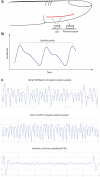NICE atrial fibrillation guideline snubs wearable technology: a missed opportunity?
- PMID: 35078798
- PMCID: PMC8813025
- DOI: 10.7861/clinmed.2021-0436
NICE atrial fibrillation guideline snubs wearable technology: a missed opportunity?
Abstract
Atrial fibrillation (AF) is the most common sustained cardiac arrhythmia and a growing public health epidemic. In the UK, over 1.3 million people have a diagnosis of AF and an estimated 400,000 remain undiagnosed. AF-related strokes account for a quarter of all strokes and, as AF episodes are often asymptomatic, are still often the first manifestation of AF. Early diagnosis and initiation of oral anticoagulation, where appropriate, may prevent some of these thromboembolic strokes. Public Health England is committed to decrease the incidence of AF-related strokes and has sponsored initiatives aimed at improving AF detection by promoting the uptake of wearable technologies. However, the National Institute for Health and Care Excellence (NICE) has not recommended wearable technology in their recent AF diagnosis and management guidelines (NG196). Diagnostic accuracy of single-lead electrocardiography (ECG) generated by the latest iteration of wearable devices is excellent and, in many cases, superior to general practitioner interpretation of the 12-lead ECG. High-quality ECG from wearable devices that unequivocally shows AF can expedite AF detection. Otherwise, there is a real risk of delaying AF diagnosis with the potential of devastating consequences for patients and their families.
Keywords: NICE; atrial fibrillation; digital health technology; stroke prevention; wearables.
© Royal College of Physicians 2022. All rights reserved.
Figures



References
-
- Public Health England . Public Health Profiles. Public Health England. https://fingertips.phe.org.uk/search/atrial
-
- Odutayo A, Wong CX, Hsiao AJ, et al. . Atrial fibrillation and risks of cardiovascular disease, renal disease, and death: systematic review and meta-analysis. BMJ 2016;354:i4482. - PubMed
-
- Atrial fibrillation prevalence estimates for local populations. https://www.gov.uk/government/publications/atrial-fibrillation-prevalenc... [Last accessed 12 May 2015].
-
- NHS England . The NHS Long Term Plan. NHS, 2019. www.england.nhs.uk/long-term-plan [Accessed 11 May 2021].
-
- Hart RG, Pearce LA, Aguilar MI. Meta-analysis: antithrombotic therapy to prevent stroke in patients who have nonvalvular atrial fibrillation. Ann Intern Med 2007;146:857–67. - PubMed
Publication types
MeSH terms
LinkOut - more resources
Full Text Sources
Medical

